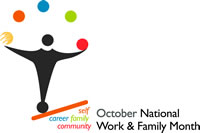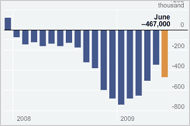Employment Outlook for 2010
Wednesday, December 30th, 2009 Employment numbers are lagging indicators of the economy. While Gross Domestic Product gained 3.5% in the third quarter of 2009, payrolls continued to fall. Job losses announced in November were 11,000. The number is the lowest monthly job loss since December 2007 and the eighth consecutive month where losses were fewer than the month before. As we close out 2009, what is the U.S. employment outlook for next year?
Employment numbers are lagging indicators of the economy. While Gross Domestic Product gained 3.5% in the third quarter of 2009, payrolls continued to fall. Job losses announced in November were 11,000. The number is the lowest monthly job loss since December 2007 and the eighth consecutive month where losses were fewer than the month before. As we close out 2009, what is the U.S. employment outlook for next year?
Unemployment is expected to peak sometime next year, and remain around 10% through 2010 and into 2011. However, the huge losses suffered at the beginning of 2009, when 700,000 jobs were lost per month appear to be behind us.
In addition, temp jobs increased in November, and unemployment fell by 0.2% to 10%. Economists had expected an unchanged rate, so the drop is a good sign. The Labor Department also revised job losses for September and October, form 190,000 to 111,000 in October, and from 219,000 to 139,000 in September.
Other indicators are strengthening as well. The stock market is up and business investment in equipment and software increased in the third quarter. According to economists, meaningful job growth is expected by the end of 2010, spurred both by federal government investment and private employer hiring. Additional indicators: consumer spending was up in November by .5%, while personal incomes were up .4%.
The average number of hours worked each week has fallen throughout the recession. But in November, the average workweek increased by .2 hour to 33.2 hours. The manufacturing workweek increased .3 hour to 40.4 hours. Still, there are 15.4 million unemployed persons in the U.S. and the number of folks working part-time due to cut hours or inability to find full-time work was little changed at 9.2%.
Americans are working hard; productivity is growing. Output rose by 4% while number of hours fell by 5%. This indicates that employers are doing more with less—and may not need to add workers just yet.
But in the long run, increasing productivity is expected to increase demand for workers, as well. What is your company’s employment plan for 2010?




 After layoffs, benefits cuts and asking staff to do without, employers look for ways to boost employees’ spirits. Some buy lunch, while others encourage fun with Halloween costumes. But some inventive employers seek ideas beyond the norm to improve morale and keep employees productive.
After layoffs, benefits cuts and asking staff to do without, employers look for ways to boost employees’ spirits. Some buy lunch, while others encourage fun with Halloween costumes. But some inventive employers seek ideas beyond the norm to improve morale and keep employees productive. The US Congress designated October as
The US Congress designated October as 



